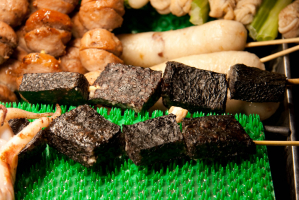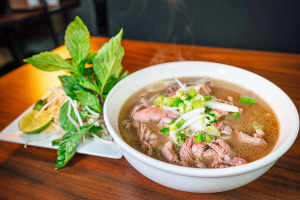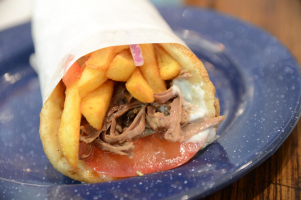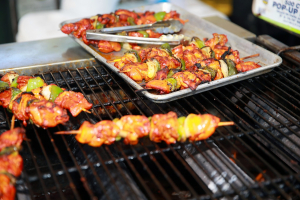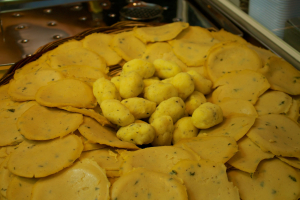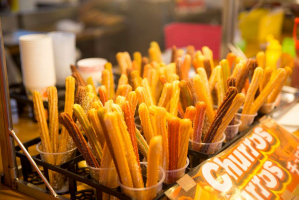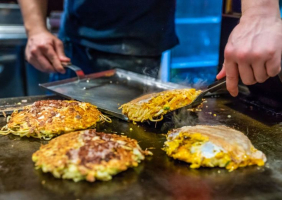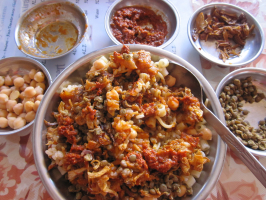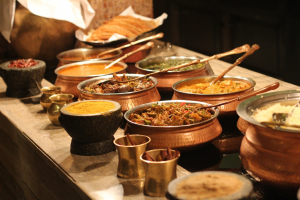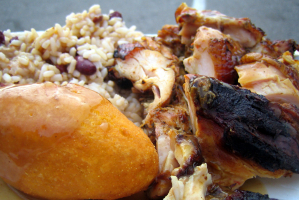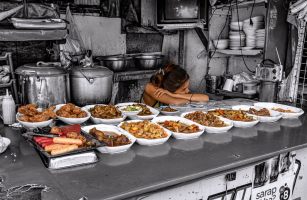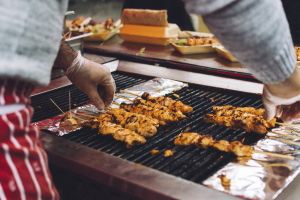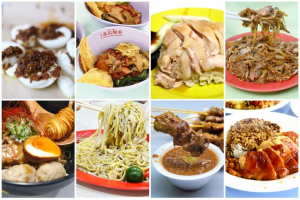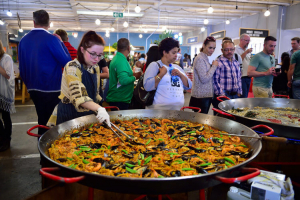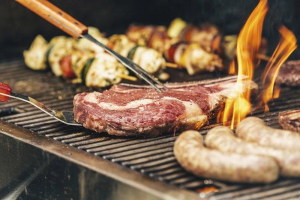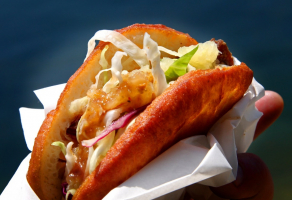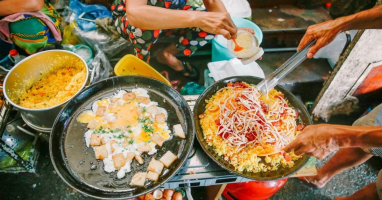Top 14 Most Popular Pakistani Street Foods
The bustling streets of Pakistan are a culinary treasure trove, where flavors blend and awaken the senses. In this article, explore the "14 most popular street ... read more...foods in Pakistan", offering a tantalizing taste of the country's culinary arts that stretch from Karachi to Lahore, turning the streets into culinary playgrounds. Truly for food enthusiasts.
-
Ranked first in our list of the "Top 14 Most Popular Pakistani Street Foods," Karahi is a dish that embodies the essence of Pakistan's rich and diverse food culture.
Karahi, often pronounced as "kar-hi," derives its name from the deep, wok-like vessel in which it's traditionally prepared. Where succulent pieces of meat or poultry, commonly chicken or mutton, are cooked to perfection in a compelling blend of spices and ingredients. While Karahi is a classic throughout the country, you'll find regional variations that make each serving a unique experience.
A generous helping of ghee or cooking oil forms the base of the dish, imparting a rich and mouthwatering aroma. A medley of spices, including cumin, coriander, and garam masala, is added, infusing the oil with its fragrant essence. Chopped onions, garlic, and ginger join the mix, creating a harmonious balance of flavors. The main star of the show, the meat, is introduced to the sizzling cauldron and seared to perfection, absorbing the myriad of spices and aromatics.
But what truly sets Karahi apart is its unique cooking vessel. The high, curved sides of the karahi allow the meat to simmer in its own juices, enhancing the depth of flavor and ensuring that each bite is a succulent delight. This method of cooking results in tender, juicy pieces of meat with a slightly crispy exterior.
Karahi is versatile, as it can be customized to suit individual preferences. Some prefer it with a spicy kick, while others enjoy a milder version, complemented by fresh herbs and a squeeze of lemon. It's often garnished with a generous sprinkling of chopped green chilies, fresh coriander, and julienne-cut ginger, elevating both its visual appeal and taste.
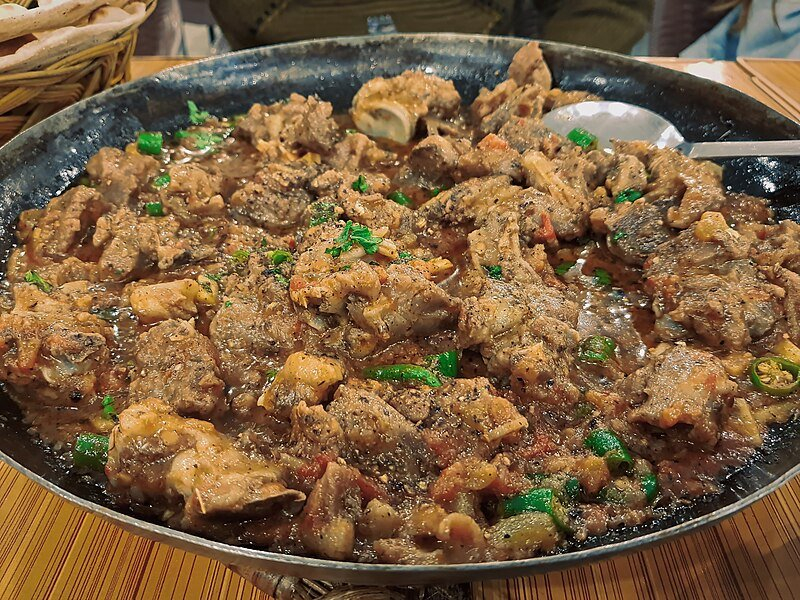
Screenshot of https://commons.wikimedia.org/wiki/File:Dumba_Karahi_20210605.jpg Video by Spice Eats -
Nalli Biryani is a delectable South Asian culinary creation renowned for its aromatic flavors and tender meat. The history of this dish is a testament to the rich tapestry of Indian cuisine.
The origins of Nalli Biryani can be traced back to the Mughal Empire in the Indian subcontinent during the 16th century. The Mughals, known for their love of food and refinement of culinary arts, brought with them the concept of Biryani from Persia. This fragrant rice dish, a blend of rice and meat with aromatic spices, quickly gained popularity.
Nalli Biryani, specifically, gained recognition due to its unique focus on the nalli, which means 'marrow' in Hindi. The Nalli refers to the succulent bone marrow found in meat, particularly in cuts of lamb or goat, which adds a rich buttery element to the dish.
Over time, as Biryani spread across the Indian Subcontinent, regional variations emerged. Nalli Biryani became a specialty, particularly in North India and Hyderabad. The dish was prepared with marinated meat, spices, fragrant Basmati rice, and slow-cooked to perfection. The marrow in the bones imparted a distinctive, luxurious flavor to the dish.
Nalli Biryani's development continued as it adapted to regional preferences. It's often characterized by its tender meat, aromatic saffron-infused rice, and an array of spices, creating a harmonious blend of flavors. Today, Nalli Biryani remains a beloved dish in Indian cuisine, both within the country and among international food enthusiasts.
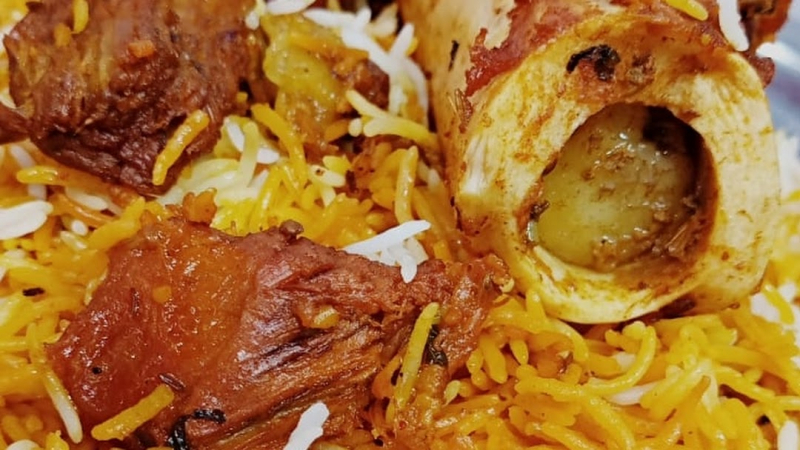
Screenshot of https://ghousia-nalli.business.site/ Video by Food Fusion -
Nihari, a slow-cooked, flavorful stew originating from the Indian subcontinent, has a timeless and universal appeal that transcends borders and cultures. Nihari is a harmonious blend of robust spices, succulent meat, and slow-cooked goodness. The extensive use of spices like cardamom, cinnamon, cloves, and ginger infuses the dish with a tantalizing aroma and an intricate flavor profile that keeps food enthusiasts returning for more.
Traditionally made with slow-cooked cuts of beef or mutton, the meat in Nihari is cooked to perfection, resulting in a tender, melt-in-the-mouth texture. The long, slow simmering process allows the flavors to penetrate deep into the meat, creating a culinary masterpiece. Nihari is more than just a dish; it's a cultural icon. It is often associated with special occasions, family gatherings, and holiday feasts. Its preparation and consumption are rituals that bring people together, creating a sense of unity and celebration.
It is commonly served with naan or paratha, which helps soak up the flavorful gravy. The dish is often garnished with fresh coriander, green chilies, and a squeeze of lemon, adding layers of freshness and heat to each bite. Nihari's history dates back to the Mughal era, and it has remained an enduring culinary tradition. Its historical significance adds an extra layer of intrigue and charm, making it a dish that connects the present with the past.
Nihari has evolved to cater to diverse tastes and dietary preferences. While the traditional version uses beef or mutton, variations with chicken and even vegetarian options are now available, ensuring that everyone can savor its unique flavors. The appeal of Nihari transcends culinary boundaries and cultural differences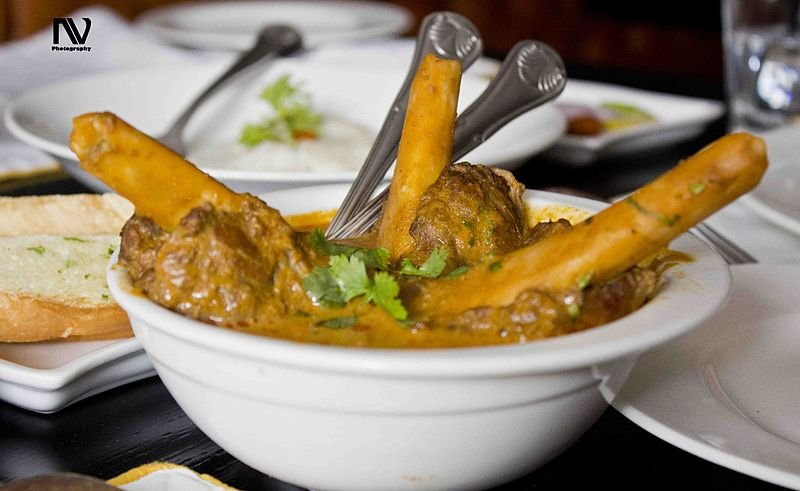
Screenshot of https://commons.wikimedia.org/wiki/File:Gosht_Paya_Nihari.jpg Video by Food Fusion -
Pakistani cuisine is renowned for its rich and diverse flavors, and Chicken Tikka Masala seamlessly blends with this tradition. The dish combines tender chicken pieces with a luscious tomato-based gravy infused with aromatic spices, showcasing the country's love for bold and complex flavors.
Chicken Tikka, a key component of Chicken Tikka Masala, is marinated and traditionally cooked in a tandoor, a clay oven. Tandoori cooking is a significant part of Pakistani culinary culture, and the smoky, charred flavors of the tandoor are deeply appreciated. Pakistani home cooks and chefs have embraced this dish, customizing it to suit their taste preferences. Some add extra heat with chili peppers, while others may make it creamier for a milder profile. This adaptability allows it to cater to a wide range of palates.
Chicken Tikka Masala offers comfort, both in flavor and in the sense of nostalgia. It's a dish that brings warmth and familiarity, evoking fond memories of family gatherings, celebrations, and cozy dinners. Pakistani cuisine is a fusion of various culinary traditions, from Mughal influences to regional specialties. Chicken Tikka Masala embodies this fusion, blending indigenous flavors with British and Indian elements, resulting in a harmonious and delightful culinary creation.
The ingredients used in Chicken Tikka Masala are readily available in Pakistan, making it an accessible and practical dish to prepare. The combination of chicken, tomatoes, spices, and yogurt or cream is easily found in local markets. Chicken Tikka Masala is beloved not just in Pakistan but also worldwide. Its global recognition as a delectable and accessible dish adds to its appeal for Pakistani people who have grown up with it. Chicken Tikka Masala's popularity in Pakistan can be attributed to its alignment with the country's culinary traditions, its adaptability, the comfort it provides, and its fusion of flavors.
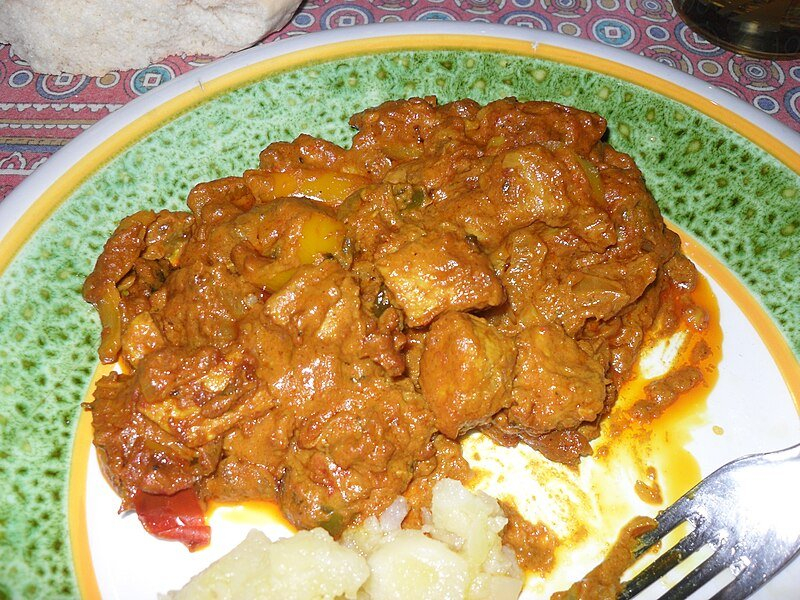
Screenshot of https://commons.wikimedia.org/wiki/File:Chicken_tikka_masala_from_Italy.JPG Video by Munchies -
Shawarma, a beloved street food on Pakistani streets, offers a compelling and unforgettable taste experience. It's a culinary delight that combines a medley of flavors, textures, and aromas, making it a favorite among locals and visitors alike. The heart of a shawarma is its succulent, thinly sliced meat, traditionally lamb or chicken. These meat slices are typically marinated with a fragrant blend of spices, including cumin, coriander, paprika, and garlic, creating a harmonious fusion of earthy and savory notes.
Pakistani shawarma vendors often incorporate local spices and herbs, infusing the meat with freshness and spice. Ingredients like mint, parsley, and sumac are added to provide a delightful contrast to the rich, roasted meat. Shawarma in Pakistan is generously slathered with creamy sauces. Garlic sauce, tahini, and yogurt-based condiments are popular choices. These sauces not only add a luxurious creaminess but also balance the spice with a cool and refreshing element. The creamy sauces also contain hints of garlic, enhancing the overall flavor profile.
To complement the savory meat and creamy sauces, Pakistani shawarma often includes fresh and crunchy accompaniments. Slices of crisp cucumbers, ripe tomatoes, and vibrant lettuce add a textural contrast and a burst of freshness with every bite. Shawarma is typically wrapped in warm, soft flatbreads or pita.
For those who enjoy a little heat, shawarma in Pakistan often features chili sauces or pickled peppers on the side. These spicy elements provide an optional, fiery kick that can be customized to suit individual preferences.
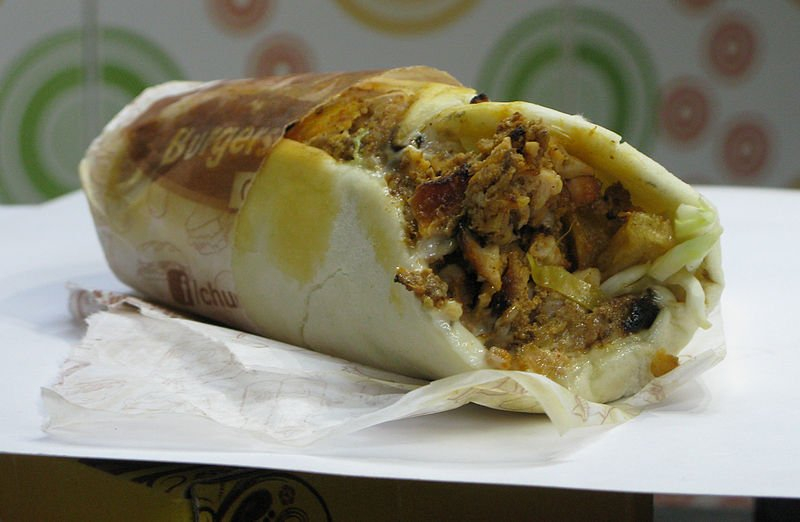
Screenshot of https://commons.wikimedia.org/wiki/File:Chicken_Shawarma.jpg Video by Tahini's -
Ranked 6th in the Top 14 Most Popular Pakistani Street Foods is Haleem. Haleem a, a celebrated dish in South Asian and Middle Eastern cuisine, is a culinary masterpiece that weaves together history, tradition, and a symphony of flavors. This beloved delicacy has a rich heritage, making it more than just a meal; it's a cultural and gastronomic experience. Haleem's origins can be traced back to the Middle East, dating back several centuries.
At its core, haleem is a savory porridge made by simmering a combination of wheat, barley, or other grains with a medley of protein, typically including meat (commonly chicken, beef, or mutton), lentils, and aromatic spices. This mixture is slowly cooked to create a thick, creamy, and velvety texture.
One of the defining features of Haleem is the lengthy cooking process. The ingredients are simmered for hours, often overnight, resulting in the grains and meat breaking down, creating a unified, cohesive texture. This slow-cooking method allows the spices to infuse and the flavors to meld, producing a harmonious and aromatic blend.
Haleem is known for its unique blend of spices, which typically includes cinnamon, cardamom, cloves, and nutmeg, among others. Haleem is more than just a meal; it holds cultural significance, particularly during the holy month of Ramadan.
In many regions, it is a popular dish for Iftar, the evening meal when Muslims break their fast. The communal preparation and consumption of Haleem during this time bring people together in a spirit of unity and reflection.
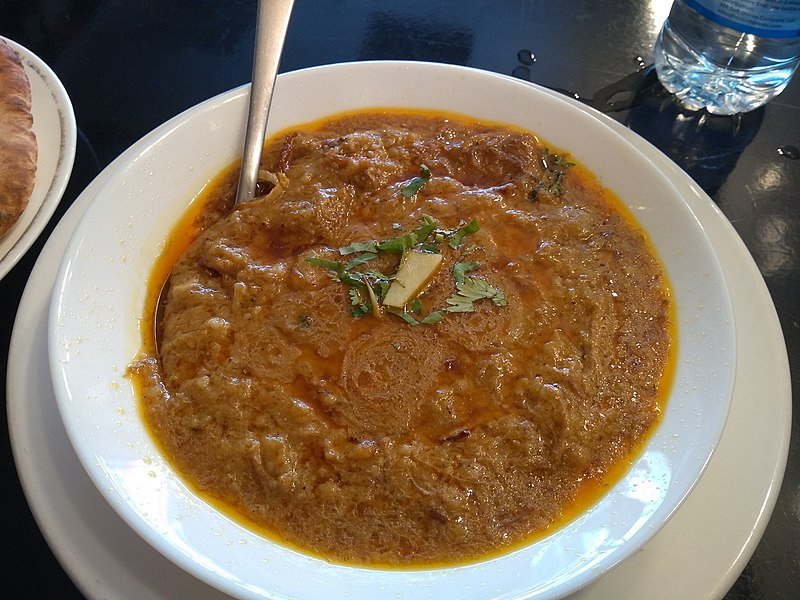
Screenshot of https://commons.wikimedia.org/wiki/File:Haleem_at_zaika.jpg Video by Food Fusion -
Nihari, a slow-cooked, flavorful stew originating from the Indian subcontinent, has a timeless and universal appeal that transcends borders and cultures. Nihari is a harmonious blend of robust spices, succulent meat, and slow-cooked goodness. The extensive use of spices like cardamom, cinnamon, cloves, and ginger infuses the dish with a tantalizing aroma and an intricate flavor profile that keeps food enthusiasts coming back for more.
Traditionally made with slow-cooked cuts of beef or mutton, the meat in Nihari is cooked to perfection, resulting in a tender, melt-in-the-mouth texture. The long, slow simmering process allows the flavors to penetrate deep into the meat, creating a culinary masterpiece. It is often associated with special occasions, family gatherings, and holiday feasts.
Nihari's versatility allows it to be paired with a variety of accompaniments. It is commonly served with naan or paratha, which helps soak up the flavorful gravy. The dish is often garnished with fresh coriander, green chilies, and a squeeze of lemon, adding layers of freshness and heat to each bite. Nihari is the epitome of comfort food. The warmth and depth of its flavors, combined with the tender meat, offer a soothing and satisfying experience.
Nihari's history dates back to the Mughal era, and it has remained an enduring culinary tradition. Its historical significance adds an extra layer of intrigue and charm, making it a dish that connects the present with the past. Nihari has evolved over the years to cater to diverse tastes and dietary preferences. While the traditional version uses beef or mutton, variations with chicken and even vegetarian options are now available, ensuring that everyone can savor its unique flavors.
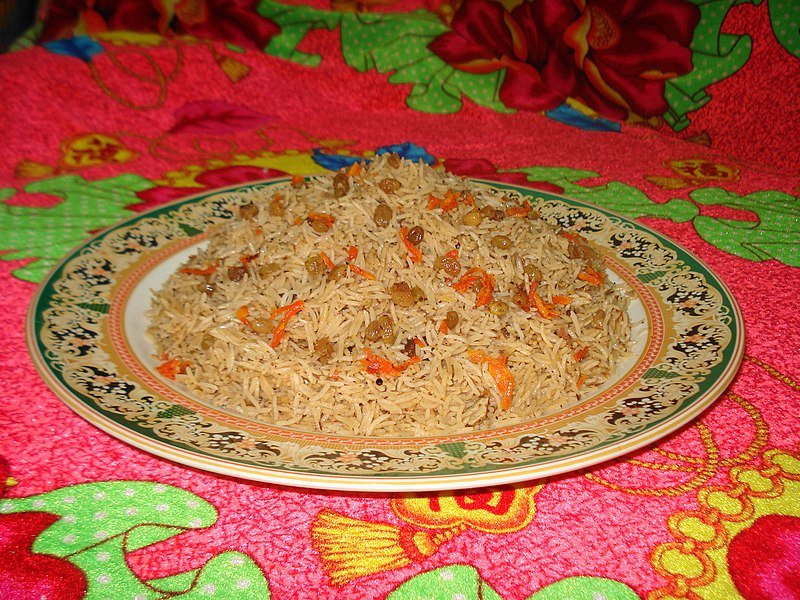
Screenshot of https://commons.wikimedia.org/wiki/File:Afghani_Pulao.JPG Video by Food Fusion -
Pakora, also spelled "pakoda," is a popular and beloved fried snack in South Asian cuisine, particularly in India, Pakistan, and Bangladesh. These delightful, bite-sized morsels are cherished for their irresistible combination of crispy exteriors and tender, flavorful interiors. Pakoras are a versatile treat, enjoyed as appetizers, street food, or accompaniments to meals, and they come in a wide variety of flavors and preparations.
To make pakoras, vegetables, or occasionally even meat, are coated in a seasoned gram flour (chickpea flour) batter, which lends them their signature crispiness when fried. The batter typically includes spices like cumin, coriander, chili powder, and garam masala, which infuse the pakoras with a robust, savory taste. Herbs like cilantro or fenugreek leaves may be added to enhance the flavor profile.
Pakoras are incredibly versatile, with a diverse range of ingredients used to create them. Some of the most common varieties include onion pakoras, made with thinly sliced onions, and aloo pakoras, which feature potato slices.
One of the most appealing aspects of pakoras is their satisfying crunch. The gram flour coating crisps up beautifully when deep-fried, while the spices in the batter and the flavor of the main ingredient create an explosion of taste with every bite.Pakoras are a common sight at street food stalls and local food markets, where they are freshly fried and served piping hot. They are also a beloved homemade comfort food, frequently enjoyed with hot tea during rainy weather or as a popular snack during festivities and celebrations.
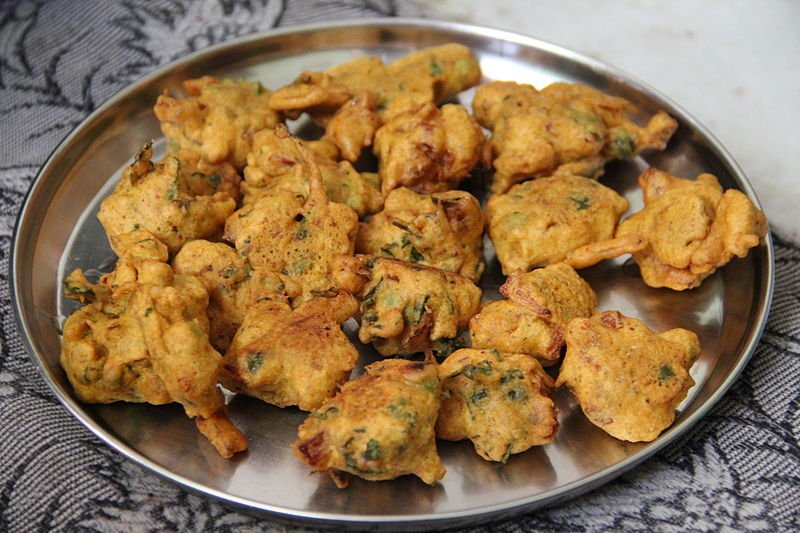
Screenshot of https://commons.wikimedia.org/wiki/File:Pakora_in_India_February_2013.jpg Video by Yes I Can Cook -
Bhutta, often called corn on the cob, is a beloved street food in India and many parts of South Asia. Its popularity transcends borders, making it a cherished treat not only in India but also in neighboring Pakistan, where it is known as "Bhutta." This humble and wholesome snack has a universal appeal that transcends age and background, making it a go-to choice for people from all walks of life.
A steaming ear of bhutta, grilled or roasted to smoky perfection, is a sensory delight. The tantalizing aroma of roasting corn wafts through the air, drawing in passersby with its irresistible allure. Vendors skillfully char the corn, often brushing it with spices and lemon juice, adding an extra layer of flavor.
What makes Bhutta truly special is its versatility. It can be customized to suit individual tastes. Some prefer it slathered in a spicy chili and lime mixture, giving it a zesty kick, while others opt for a milder flavor with a touch of butter and salt. Additionally, you can find variations like masala bhutta, where a blend of aromatic spices transforms the corn into a savory delight.
Whether you're strolling along a beachside promenade or exploring the bustling streets of a city, the sight of a bhutta vendor is a warm invitation to savor a slice of Indian and South Asian street food culture. Beyond its irresistible taste, bhutta holds a special place in the hearts of those who relish its simplicity and familiarity.
It's a reminder that some of life's greatest pleasures can be found in the simplest foods. So, the next time you encounter a steaming ear of bhutta, take a moment to savor this iconic street food that brings joy and togetherness to all who indulge in its smoky, sweet, and savory embrace.
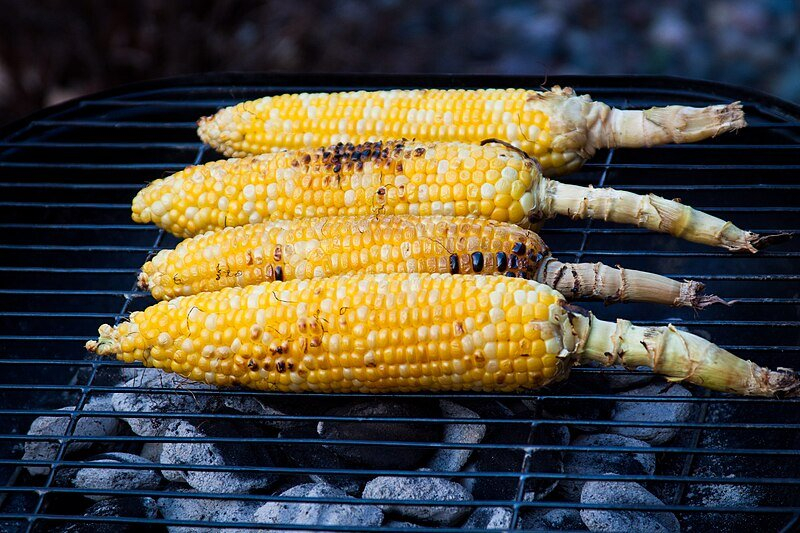
Screenshot of https://commons.wikimedia.org/wiki/File:Bhutta_or_corn_on_the_cob_Indian_style.jpg Video by Desi Cooking -
Masala French Fries have gained popularity on Pakistani streets as a delightful and flavorful street food option. While traditional French fries are a beloved snack, adding a masala twist has made them even more appealing to Pakistani customers.
The combination of crispy French fries and a medley of spices, including chaat masala, red chili powder, cumin, and more, creates a burst of flavors that resonate with local tastes. Pakistani street food culture has always embraced bold and spicy flavors, making Masala French Fries a natural fit.
Customers in Pakistan have embraced this fusion of Western and South Asian culinary elements. The spiced fries offer a unique and addictive flavor, making them a sought-after street food. They cater to the nation's love for snacks that are both convenient and packed with taste. Street vendors and food stalls often offer Masala French Fries alongside other popular local snacks like samosas and chaat, making them a common choice for those seeking a quick and satisfying bite while on the go.
The popularity of Masala French Fries on Pakistani streets highlights the adaptability of street food and its ability to infuse global flavors into local favorites. These seasoned fries have seamlessly integrated into the diverse tapestry of Pakistani street food, offering a savory and spicy experience that keeps customers returning for more.
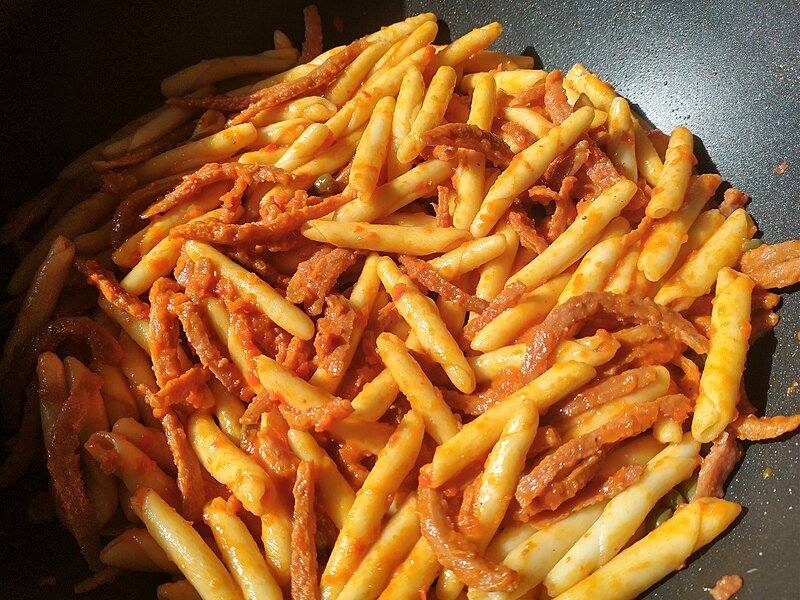
Screenshot of https://commons.wikimedia.org/wiki/File:%C5%A0urlice_%281%29.jpg Video by Your Food Lab -
The history of chaat on Pakistani streets is a tale of culinary fusion, adaptation, and unceasing popularity. Chaat, a delightful and tangy street food, has its roots in the Indian subcontinent and arrived in Pakistan through historical migrations and cultural exchanges.
Chaat's origins can be traced back to North India, where it was initially a simple combination of fried dough, potatoes, and chutneys. As Indian immigrants settled in various parts of Pakistan after the partition of 1947, they brought with them their culinary traditions, including chaat. Over time, these recipes transformed, adapting to local tastes and ingredients.
Pakistani chaat has evolved to include an array of unique regional variations. In Karachi, for instance, aloo chaat became a street food staple. This variation features crispy fried potato cubes with spices, chilies, and chutneys. In Lahore, the famous Dahi Puri and Papri Chaat became popular, offering a delightful blend of yogurt, crisp wafers, and various sweet and savory toppings.
Different regions put their spin on this beloved street food, adding flavors and ingredients that resonate with their local preferences. Today, chaat has become an integral part of Pakistan's street food culture, offering a delightful burst of flavors, textures, and spices that captivate taste buds nationwide.
Whether enjoyed in the bustling streets of Karachi, the historic lanes of Lahore, or the vibrant markets of Islamabad, chaat is a testament to the enduring appeal of street food in Pakistan, blending heritage with innovation.
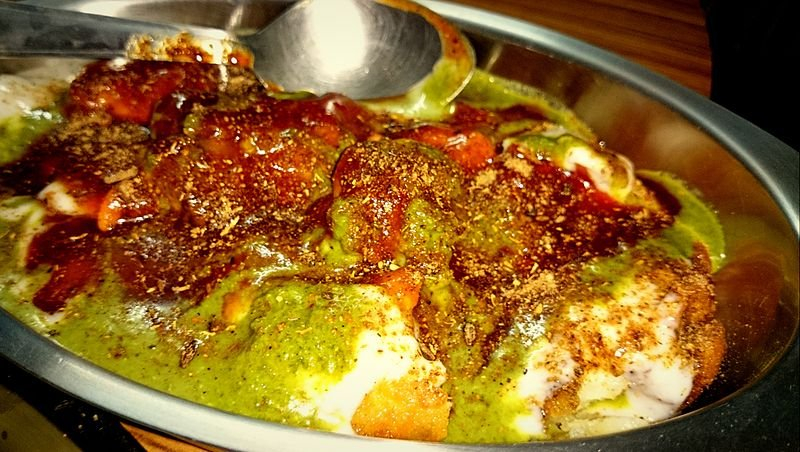
Screenshot of https://commons.wikimedia.org/wiki/File:Aloo_Tikki_%28Chaat%29.jpg Video by Chef Ranveer Brar -
Paratha is a popular and versatile unleavened flatbread from the Indian subcontinent. This delectable bread is a staple in the region, cherished for its simple yet mouthwatering preparation and ability to pair well with a wide range of accompaniments.
To make paratha, whole wheat flour is the primary ingredient, though variations using other flour like gram flour (besan) or refined flour (maida) exist. The flour is mixed with water and a pinch of salt to form a pliable dough. This dough is divided into smaller portions into thin, round discs. These discs are traditionally cooked on a hot griddle or tava, using a modest amount of ghee (clarified butter) or oil. The result is a golden, flaky, and slightly crispy bread.
What sets Paratha apart from ordinary flatbreads is its versatility. It can be stuffed with various fillings, such as spiced potatoes (aloo), paneer (Indian cottage cheese), minced meat, or various vegetables and spices. This stuffing elevates the paratha into an incredibly flavorful and satisfying dish. The flatbread can also be seasoned with spices like cumin, coriander, or ajwain, adding an extra layer of taste.
Parathas are enjoyed across the subcontinent, and their popularity extends to breakfast, lunch, dinner, or even as a snack. They are often served with various accompaniments, such as yogurt, pickles, chutneys, or curry dishes.
Parathas are cherished not only for their delicious taste but also for their ability to be customized to suit diverse tastes and preferences, making them a beloved and essential part of Indian and Pakistani cuisine.
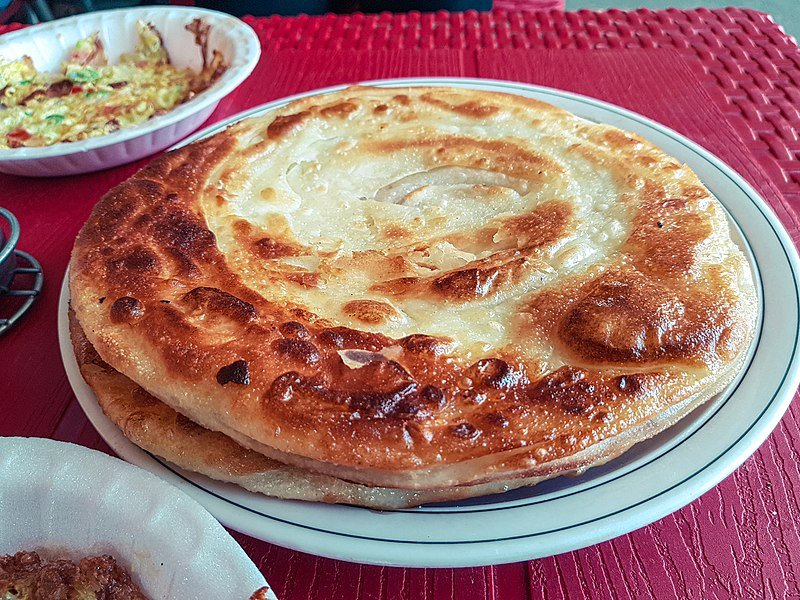
Screenshot of https://commons.wikimedia.org/wiki/File:Paratha_is_a_dough_fried_flatbread_native_to_India_and_Pakistan.jpg Video by Rajshri Food -
Also in the Top 14 Most Popular Pakistani Street Foods is Halwa Puri. It is a beloved and traditional Pakistani breakfast with a rich history of popularity on the bustling streets of Pakistan. This delightful combination of crispy puris (deep-fried bread) and sweet semolina pudding, or halwa, has become a staple of the country's street food culture.
The origins of Halwa Puri in Pakistan can be traced back to its South Asian roots, influenced by the Indian subcontinent's diverse culinary traditions. The dish was traditionally prepared as a festive or celebratory meal, often served during religious and cultural events.
Halwa Puri's journey to the streets of Pakistan's cities is a story of cultural preservation and adaptation. As the country gained independence in 1947 and urbanization increased, the bustling streets and markets of Karachi, Lahore, and other major cities provided an ideal platform for this hearty breakfast to flourish.
Street vendors and small eateries started offering Halwa Puri, making it accessible and affordable for people on the go. The dish's rich, aromatic flavors and affordable price point quickly endeared it to the working class and students looking for a filling and satisfying meal.
The availability of Halwa Puri on Pakistani streets soon led to its widespread popularity. Its reputation as a wholesome and flavorful breakfast option continued to grow, and it became a weekend tradition for many families, creating a sense of comfort and community. Halwa Puri stands as an iconic representation of Pakistan's street food culture.
Whether you're enjoying it at a traditional street-side stall or a modern eatery, this dish remains a testament to the enduring appeal of authentic, homegrown flavors and the power of street food to unite people over a delicious, communal meal.
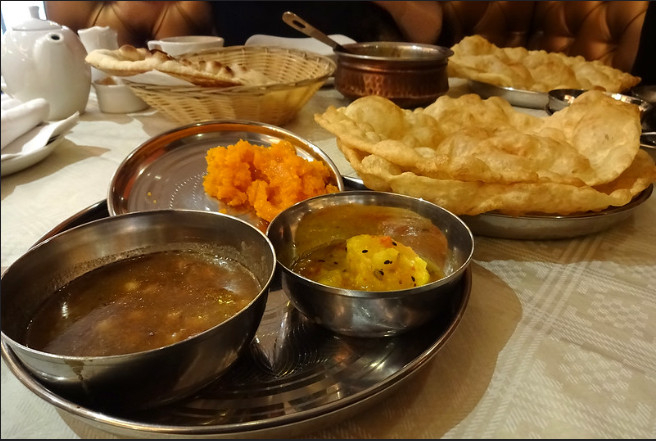
Screenshot of https://www.flickr.com/photos/kake_pugh/35919679836 Video by Ijaz Ansari Food Secrets -
This delectable dish consists of soft lentil dumplings, known as bhallas, immersed in creamy yogurt and topped with tantalizing spices, chutneys, and garnishes. The cool and creamy yogurt in Dahi Bhalla offers a refreshing contrast to the spicier elements, making it a perfect choice on a hot day. The yogurt's tanginess combines harmoniously with the savory flavors, creating a delightful balance. They provide a delightful contrast to the crunchy garnishes like sev, pomegranate seeds, and crisp fried wafers, offering a symphony of textures in each bite.
Dahi Bhalla is all about layers of flavor. The lentil dumplings are seasoned with aromatic spices, and the chutneys add sweet, tangy, and spicy notes. As you take a bite, you experience an explosion of tastes that tickle your taste buds. One of the joys of Dahi Bhalla is its adaptability. Customers can personalize their dishes by adjusting the spiciness, sweetness, and choice of garnishes. This versatility allows everyone to tailor the dish to their own liking.
Dahi Bhalla is a beloved part of Indian and Pakistani culinary traditions. It's often associated with festive occasions, family gatherings, and cherished memories. For many, indulging in Dahi Bhalla is like receiving a warm and delicious hug from their cultural heritage.
Dahi Bhalla's street food status adds to its allure. It's an affordable and easily accessible snack, making it a favorite for people from all walks of life. Whether you're exploring a bustling market, a busy street corner, or a local food festival, Dahi Bhalla is a comforting and convenient delight.
The reasons behind customers' love for Dahi Bhalla are as diverse as the dish itself. From its comforting familiarity to its tantalizing fusion of flavors, this street food classic has earned a special place in the hearts and palates of food enthusiasts across the Indian subcontinent and beyond.
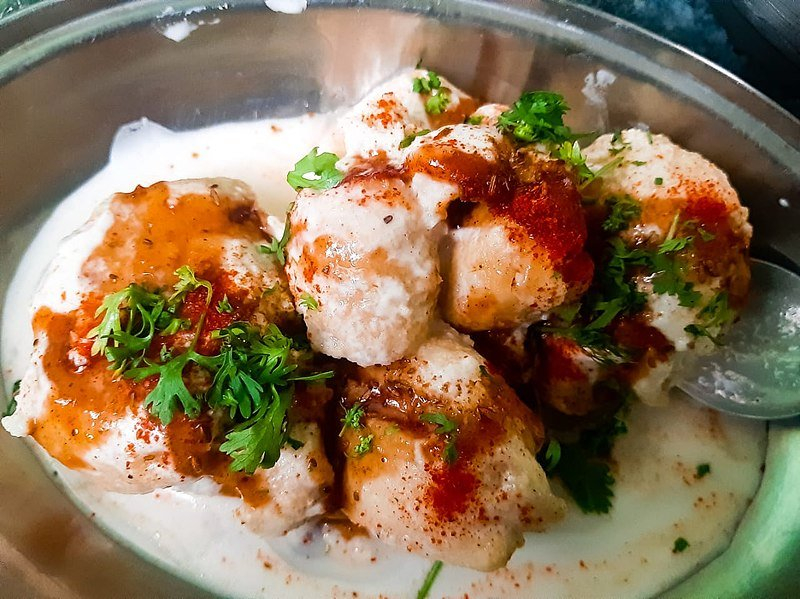
Screenshot of https://commons.wikimedia.org/wiki/File:Dahi_Vada_Bihari_Style.jpg Video by Hebbars Kitchen
















